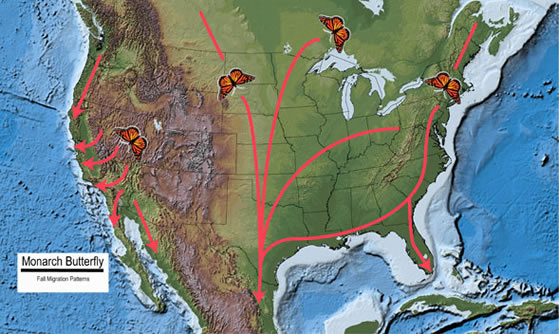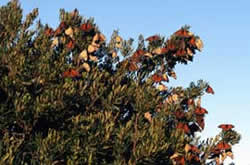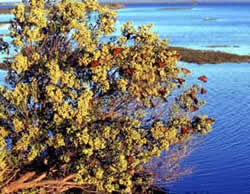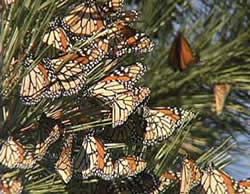- Forest Service Home
- Celebrating Wildflowers
- Home
- About Us
- News & Events
- Wildflower Viewing Areas
- Wildflower Ethics
- Forest Service Regions
- Just For Kids
- Teacher Resources
- Pollinators
- Native Gardening
- Native Plant Materials
- Invasive Plants
- Rare Plants
- Beauty of It All
- Interesting Plants
- Unique Communities
- Ethnobotany
- Special Features
- Wildflower Links
- Contact Us
USDA Forest Service Celebrating Wildflowers
|
|
|
Migration and Overwintering Monarchs can travel between 50-100 miles a day; it can take up to two months to complete their journey. The farthest ranging monarch butterfly recorded traveled 265 miles in one day. The annual migration of North America’s monarch butterfly is a unique and amazing phenomenon. The monarch is the only butterfly known to make a two-way migration as birds do. Unlike other butterflies that can overwinter as larvae, pupae, or even as adults in some species, monarchs cannot survive the cold winters of northern climates. Using environmental cues, the monarchs know when it is time to travel south for the winter. Monarchs use a combination of air currents and thermals to travel long distances. Some fly as far as 3,000 miles to reach their winter home! Where Do Monarchs Go?Monarchs in Eastern North America have a second home in the Sierra Madre Mountains of Mexico. Monarchs in Western North America overwinter in California. Eastern North American PopulationOverwintering in Mexico
The eastern population of North America’s monarchs overwinters in the same 11 to 12 mountain areas in the States of Mexico and Michoacan from October to late March. Monarchs roost for the winter in oyamel fir forests at an elevation of 2400 to 3600 meters (nearly 2 miles above sea level). The mountain hillsides of oyamel forest provide an ideal microclimate for the butterflies. Here temperatures range from 0 to 15 degrees Celsius. If the temperature is lower, the monarchs will be forced to use their fat reserves. The humidity in the oyamel forest assures the monarchs won’t dry out allowing them to conserve their energy.  Directional AidsResearchers are still investigating what directional aids monarchs use to find their overwintering location. It appears to be a combination of directional aids such as the magnetic pull of the earth and the position of the sun among others, not one in particular. Clustering in Colonies Monarch butterflies are called Mariposa monarca in Mexico. Monarchs cluster together to stay warm. Tens of thousands of monarchs can cluster on a single tree. Although monarchs alone weigh less than a gram, tens of thousands of them weigh a lot. Oyamel trees are generally able to support the clustering butterflies, but sometimes branches break. Protection of Oyamel ForestConservation of overwintering habitat is very important to the survival of monarchs. The Mexican Government recognized the importance of oyamel forests to monarch butterflies and created the Monarch Butterfly Biosphere Reserve in 1986. Western North American PopulationMonarchs living west of the Rocky Mountain range in North America overwinter in California along the Pacific coast near Santa Cruz and San Diego. Here microclimatic conditions are very similar to that in central Mexico. Monarchs roost in eucalyptus, Monterey pines, and Monterey cypresses in California. FlywaysTraveling SouthEastern North American monarchs fly south using several flyways then merge into a single flyway in Central Texas. It is truly amazing that these monarchs know the way to the overwintering sites even though this migrating generation has never before been to Mexico!
Congregation SitesMonarchs only travel during the day and need to find a roost at night. Monarchs gather close together during the cool autumn evenings. Roost sites are important to the monarch migration. Many of these locations are used year after year. Often pine, fir and cedar trees are chosen for roosting. These trees have thick canopies that moderate the temperature and humidity at the roost site. In the mornings, monarchs bask in the sunlight to warm themselves.
Use of PeninsulasMonarchs traveling south congregate on peninsulas. The shape of the peninsula funnels the migrating butterflies. At its tip, the monarchs find the shortest distance across open water. They congregate along the shore to wait for a gentle breeze to help them across.
Traveling NorthAs warm temperatures and lengthening days arrive, the migratory generation of monarchs finishes the development they halted prior to their migration. They become reproductive, breed and lay the eggs of the new generation. This starts the northern journey back to North America. Unlike the generation before them, who made a one-generation journey south, successive generations make the journey north.
Multiple GenerationsGeneration 1 monarchs are the offspring of the monarchs who overwintered in Mexico. Each successive generation travels farther north. It will take 3-4 generations to reach the northern United States and Canada. We Are ConnectedBecause all the migrating monarchs are concentrated in just a few locations during the winter, they are especially vulnerable to harsh weather and to human activities that disrupt or destroy their habitat. This can reduce the number of monarchs that leave the overwintering sites in the spring. Similarly, migrating and breeding monarch populations are vulnerable to harsh weather and to human activities that reduce milkweed and nectar sources. This can reduce the number of monarchs that reach overwintering sites. Tracking MigrationThe northern migration is tracked by an organization called Journey North. You can track the migration of the monarch butterfly by visiting this site. You can learn more about a project to track the southern migration at Papalotzin, The Journey of the Monarch Butterfly. |
|
| NOTE: PDF format links require the Adobe Acrobat Reader to view. | |
| top | Disclaimers | FOIA | Privacy Policy | Quality of Information | Photo Credits & Use |
Location: http://www.fs.fed.us/wildflowers/pollinators/monarchbutterfly/migration/index.shtml
Last modified: Tuesday, 30-Aug-2011 18:39:00 EDT







